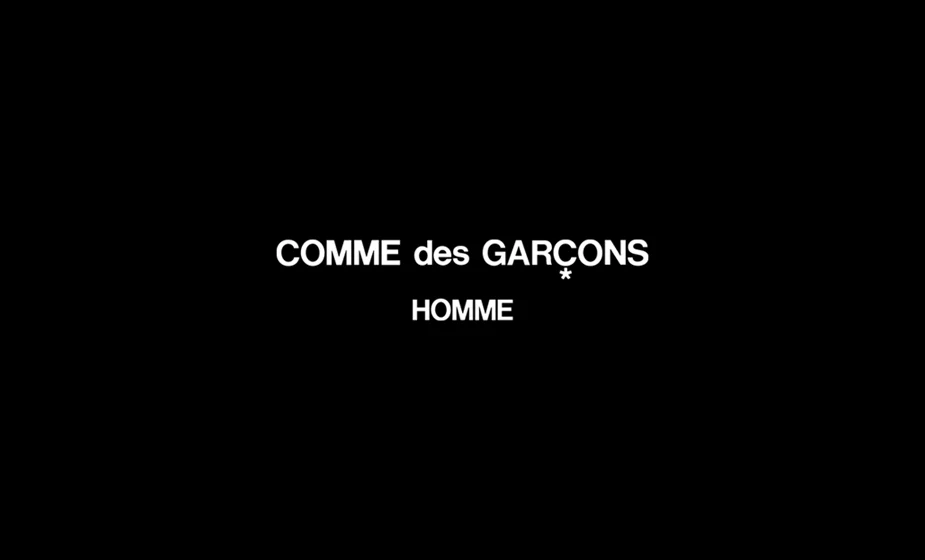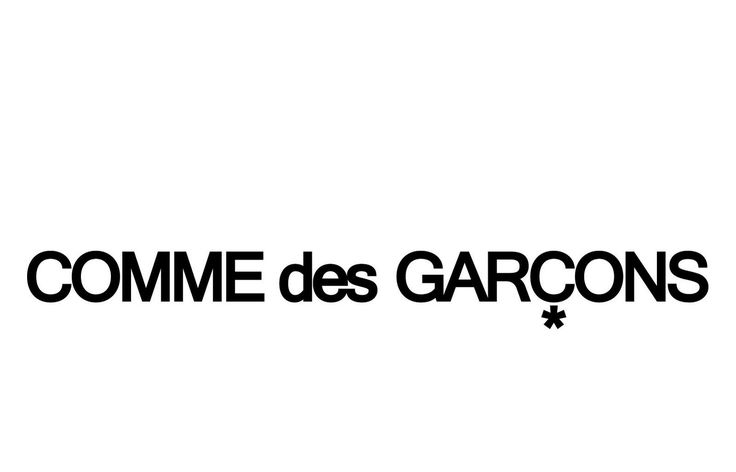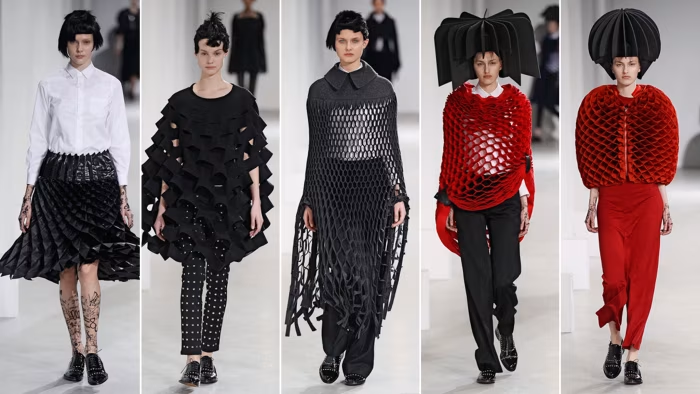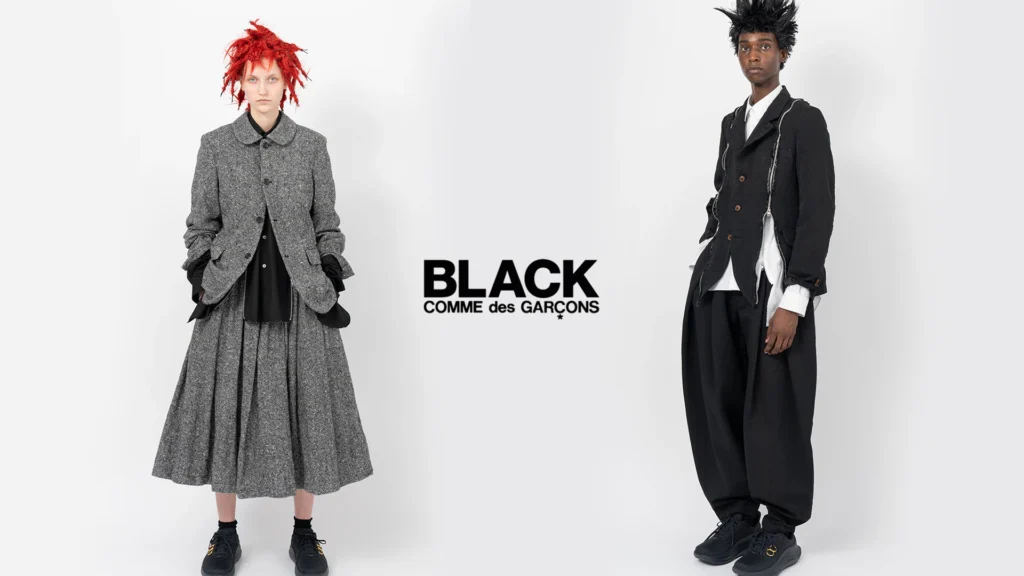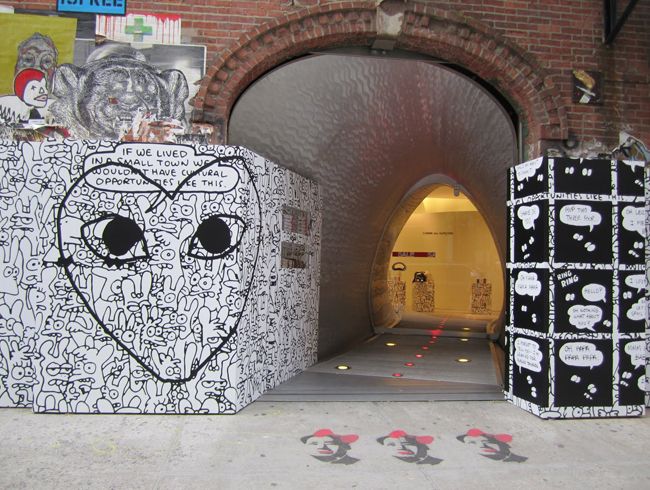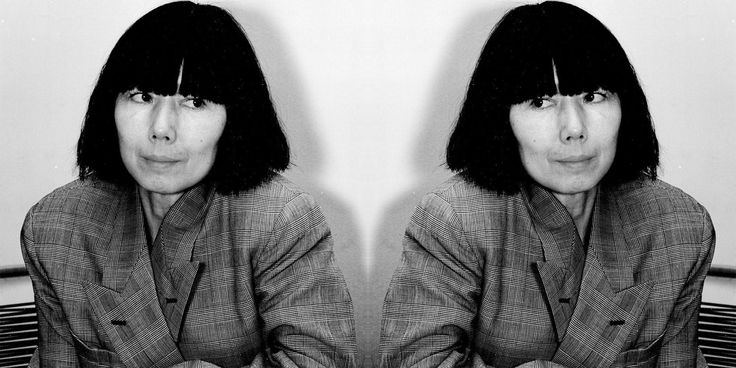By founding Comme des Garcons Homme in 1978 and Homme Plus in 1984, when she was not simply making clothes in the menswear collections, she was deconstructing centuries of masculine dress codes. These collections defeated all the beliefs on dressing and the masculine appearance of men, and the need to tailor by any rules.
Both lines are the most innovative menswear brands in fashion today. They have impacted everyone, including Raf Simons and Thom Browne, and have shown that the world of men’s fashion can be as exploratory and pushing the boundaries as any avant-garde women’s collection.
The Birth of Radical Menswear
Homme: Subverting the Suit
In 1978, Comme des Garcons Homme was the first aimed menswear house by Kawakubo. Homme indeed was the direct opposite of the classic tailoring of men, which has been known to have focused on broad shoulders, a distinct waist, and muscular shapes.
The initial collections had slouchy and oversized proportions, which rather shadowed the male body than emphasized it. The unstructured shoulders were soft and defied the power-dressing style. Bright colors gave place to a monochromatic palette based on black, gray, and navy colors. Surprisingly, linen combos were made of wool, combined with synthetic fabrics, and symmetrical detail was slightly broken in the traditional symmetry.
What was revolutionary about Homme? It implied that men could wear without enacting masculinity. The garments were not proclaiming might or sexual prowess, but merely existed as well-crafted, considerate clothes.
According to fashion historian Shaun Cole, “the Homme line by Kawakubo democratized men-based avant-garde fashion. It was experimental in a way that it was interesting, but wearable in a way that it could be worn at all.”
Homme Plus: Where Experimentation Escalates
Six years later, Comme des Garcons Homme Plus was opened with even more radical ambitions. In case Homme implied a challenge to the rules of menswear, Homme Plus destroyed them completely.
This difference between the lines is evident when the approaches to them are considered. Homme gives wearable testing and light subversion at price ranges of $300-900, as business casual insurrection. Homme Plus provides runway-oriented and unapologetically provocative designs at the price of an artistic statement at $800-3,000 plus.
Homme Plus features male models in skirts. Not kilts in masculine framing- real skirts that attacked the way gender was performed head-on. Jackets had exaggerated forms and shaped the bodies into sculptures. Pants were stretched to capacities that did not belong to sportive action or sexual exhibition.
This was not dress-up doll seduction. It was fashion as philosophy.
Deconstructing Traditional Tailoring
The Anti-Suit Suit
Both Homme and Homme Plus are excellent in making the clothes, which allude to the traditional tailoring and rethink its use entirely. A CDG Homme Plus suit jacket could have one shoulder several inches lower than the other, which makes it deliberately symmetrical. Sleeves vary in length and make the viewers doubt the right fit. Uncovered seams and unfinished edges expose ways of constructing a building that are normally concealed.
This was best demonstrated in the Summer/Spring 2019 Homme Plus collection. Tailored jackets by the models were made with one side of navy wool and the other side made of black cotton. Pants were worn with one broad leg and one narrow one. Nothing was similar, but everything functioned.
Why does this matter? It challenges the most basic delivery of menswear, the idea that garments are supposed to produce homogenous, symmetrical bodies that spur authority and dominance.
Fabric as Rebellion
Classical menswear is based on the use of the expected materials: wool in suits, cotton in shirts, and leather in shoes. Comme des Garcons Homme and Homme Plus view the selection of fabric as a creative opportunity.
Polyester taffeta got on recent collections, a tailored jacket that gives unexpected shine and rustle. Neoprene, used in wetsuits, is usually used in blazers and coats. Opaque organza veils on top of conventional suiting, and the body is seen and hidden at the same time. Garments are made into sculptural forms by rubbing the cotton.
Such material experimentation has two functions. It first doubts the feel of the proper menswear. Second, it makes itself visually engaging without the use of logos, patterns, or embellishment.
Matte black wool jacket in CDG Homme Plus could seem to be an easy wear at a distance. At a closer look, it displays four types of black fabrics providing subtle variation of texture- a sophistication that is pleasurable to look at.
Gender Fluidity Before It Was Trendy
Skirts, Dresses, and Masculine Presentation
Homme Plus has been running an operation of using skirts and dress-like clothes on men long before the introduction of gender-neutral fashion as a marketing term. This is why the Fall/Winter 2012 lineup of the collection is legendary.
The models were dressed in pleated skirts with custom-fitted jackets. Tunics are featured on top of pants. Garments made of sheer overlays produced flowing figures in layers. Traditional dresses. The exaggerated bell sleeves that had traditionally been a part of the female historical dress were used to complete outfits.
The crucial difference? These were not costumes and ironic utterances. They were introduced as true men’s clothes- useful, usable, and in the market.
Fashion critic Tim Blanks wrote: Kawakubo does cross-dress men. She wonders what was so peculiar about some clothes becoming gendered at all?
Redefining Masculine Proportions
In addition to particular types of garments, the two lines break the norms of the male body as it should be represented in clothing. The classic menswear focuses on broad-shoulderedness, slim waistlines, long, svelter legs, and exposed muscle.
The opposite is done by CDG Homme and Homme Plus. Shoulders are covered with oversized tops. Definitions are lost in dropped waistlines. Wide-leg trousers are cropped and make the leg line shorter. Making the body architectural as opposed to a display.
This style shaped a whole generation of men designers. The legacy of Kawakubo is evident when you look at the oversized Balenciaga suits that Demna Gvasalia has been doing or the slouchy tailoring of Raf Simons.
The Wearability Paradox
Experimental Yet Functional
This is the extraordinary thing about Comme des Garcons Homme, especially, despite its conceptual intentions, the clothes do look good in life.
A jacket of Homme, which has slight asymmetry, appears to be fashionable instead of a costume. The quality construction implies decades of durability for the garments. The color cast is primarily black, which covers up the garments well with the current wardrobe.
This functionality sets CDG menswear apart as compared to conceptual fashion. Whereas the mainstream women’s collections often focus on artistic expression as opposed to utility, Homme and Homme Plus still have some relation to the real-life dressing requirements of men.
An average CDG Homme collection would consist of a black wool blazer with slightly dropped shoulders, a white cotton shirt with an asymmetrical placket, gray wool trousers with a slight pleating effect, and a pair of black leather derby shoes with bulky soles. Total investment: $2,240. The high-priced and yet affordable in comparison to the runway.
The Collector’s Mindset
Homme and Homme Plus have their loyal customers who create a wardrobe over many years. These pieces are modern decades after the other trend-driven fashion because they are not outdated by the time of their next season.
CDG Homme Plus designs that were introduced in the 1990s are now reselling on sites such as Grailed at prices higher than their original selling price. A 1998 deconstructed blazer that was selling at 900 at the time is now priced at 1200-1500 in excellent condition.
Why? The design philosophy cuts across the trend cycles. Asymmetry, deconstruction, and material experimentation never go out of fashion; it is a classic way of designing a garment.
Iconic Collections That Changed Everything
The 2015 Spring/Summer ceremony, called the Ceremony of Separation, was also about division, literally cutting clothes into opposite parts. One side of the jackets was black wool, the other was white cotton. Pants are combined navy and gray. Shirts had stripes combined with solid colors.
The idea was in the context of divorce, separation, and duality. But the clothes were beautiful, even aside from the intellectual system. The divided construction made the viewing dynamic without any logos or graphics.
The Fall/Winter 2017 The Future of Silhouette had some of the most extreme proportions that Kawakabo ever presented. There were models with jackets that had shoulders six inches wider than usual. Coats swelled out into balloons. Pants had panels that formed the architectural volumes.
They were not everyday clothes but rather idea-type statements of the potential of fashion. However, the modernized forms of these figures were used in later Homme collections and thus making the ideas more available and still keeping their innovative edge.
Cultural Impact and Influence
Comme des Garcons Homme was adopted as the unofficial dress of creative people all over the world. You will see the aesthetic everywhere as you walk through design studios in Tokyo, London, or New York.
Why this demographic? The reason is that Homme lies in the golden mean between credibility and creativity in the workplace. It reads “I do not take my work lightheartedly and do not want to follow all the way.
Other distinguished customers are Pharrell Williams, who puts the Homme Plus on stage and during interviews. Tyler, the Creator, refers to CDG menswear as a significant influence on his Golf Wang brand. Frank Ocean has similarly attended several high-profile gatherings wearing Homme Plus that had been customized.
The effect is much further than direct sales. The debt is openly recognized by contemporary designers. Thom Browne based his brand on reduced proportions and reconstruction of the suit concepts Kawakubo had developed several decades ago. Craig Green also designs menswear sculpture by referring to the volumes of body-obscuring in Homme Plus.
As menswear adopted oversized silhouettes, asymmetry, and gender fluidity in the last ten years, it was taking the same direction that Comme des Garcon had made a decade earlier.
Why They Matter Today
Comme des Garcons Homme and Homme Plus have provided an alternative direction when most of the menswear is divided between sporty streetwear and business proper. They demonstrate that men can dress intelligently, experimentally, and wearably at the same time.
The lines show that there is no need to break traditions and be of no use when it comes to quality and functionality. It is possible to cut up a blazer and still have perfect tailoring. You can cover the figure and make a self-flattering figure.
Nowadays, when gender conventions are still in the process of evolution, it seems that Kawakubo, in decades of experimenting with gender presentation, is even more topical. Her questions in 1984 seem even more relevant than ever.
CDG Homme and Homme Plus are not only fashion brands. They are continuing experiments of what menswear might be if designers focused more on creativity than on convention, philosophy on profit, and long-term vision rather than on the trends of the season.
That is no tailoring with a twist. That’s fashion with a purpose.

